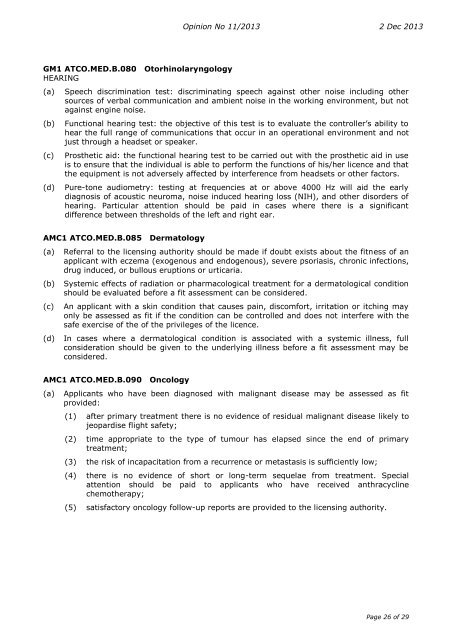AMC & GM to Part ATCO.MED - EASA
AMC & GM to Part ATCO.MED - EASA
AMC & GM to Part ATCO.MED - EASA
Create successful ePaper yourself
Turn your PDF publications into a flip-book with our unique Google optimized e-Paper software.
Opinion No 11/2013 2 Dec 2013<br />
<strong>GM</strong>1 <strong>ATCO</strong>.<strong>MED</strong>.B.080 O<strong>to</strong>rhinolaryngology<br />
HEARING<br />
(a)<br />
(b)<br />
(c)<br />
(d)<br />
Speech discrimination test: discriminating speech against other noise including other<br />
sources of verbal communication and ambient noise in the working environment, but not<br />
against engine noise.<br />
Functional hearing test: the objective of this test is <strong>to</strong> evaluate the controller’s ability <strong>to</strong><br />
hear the full range of communications that occur in an operational environment and not<br />
just through a headset or speaker.<br />
Prosthetic aid: the functional hearing test <strong>to</strong> be carried out with the prosthetic aid in use<br />
is <strong>to</strong> ensure that the individual is able <strong>to</strong> perform the functions of his/her licence and that<br />
the equipment is not adversely affected by interference from headsets or other fac<strong>to</strong>rs.<br />
Pure-<strong>to</strong>ne audiometry: testing at frequencies at or above 4000 Hz will aid the early<br />
diagnosis of acoustic neuroma, noise induced hearing loss (NIH), and other disorders of<br />
hearing. <strong>Part</strong>icular attention should be paid in cases where there is a significant<br />
difference between thresholds of the left and right ear.<br />
<strong>AMC</strong>1 <strong>ATCO</strong>.<strong>MED</strong>.B.085 Derma<strong>to</strong>logy<br />
(a)<br />
(b)<br />
(c)<br />
(d)<br />
Referral <strong>to</strong> the licensing authority should be made if doubt exists about the fitness of an<br />
applicant with eczema (exogenous and endogenous), severe psoriasis, chronic infections,<br />
drug induced, or bullous eruptions or urticaria.<br />
Systemic effects of radiation or pharmacological treatment for a derma<strong>to</strong>logical condition<br />
should be evaluated before a fit assessment can be considered.<br />
An applicant with a skin condition that causes pain, discomfort, irritation or itching may<br />
only be assessed as fit if the condition can be controlled and does not interfere with the<br />
safe exercise of the of the privileges of the licence.<br />
In cases where a derma<strong>to</strong>logical condition is associated with a systemic illness, full<br />
consideration should be given <strong>to</strong> the underlying illness before a fit assessment may be<br />
considered.<br />
<strong>AMC</strong>1 <strong>ATCO</strong>.<strong>MED</strong>.B.090 Oncology<br />
(a)<br />
Applicants who have been diagnosed with malignant disease may be assessed as fit<br />
provided:<br />
(1) after primary treatment there is no evidence of residual malignant disease likely <strong>to</strong><br />
jeopardise flight safety;<br />
(2) time appropriate <strong>to</strong> the type of tumour has elapsed since the end of primary<br />
treatment;<br />
(3) the risk of incapacitation from a recurrence or metastasis is sufficiently low;<br />
(4) there is no evidence of short or long-term sequelae from treatment. Special<br />
attention should be paid <strong>to</strong> applicants who have received anthracycline<br />
chemotherapy;<br />
(5) satisfac<strong>to</strong>ry oncology follow-up reports are provided <strong>to</strong> the licensing authority.<br />
Page 26 of 29
















